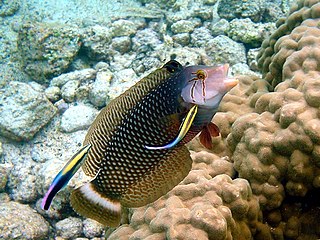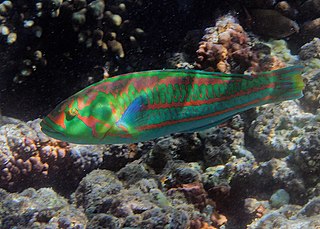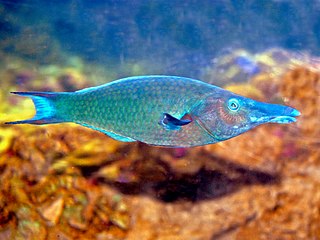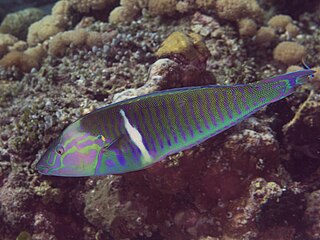
The Christmas wrasse, also known as the ladder wrasse, green-barred wrasse or green-blocked wrasse, is a species of ray-finned fish, a wrasse from the family Labridae which is native to the Indian Ocean and the western Pacific Ocean. It inhabits shallow reefs at depths from the surface to 10 m (33 ft). It is of minor importance to local commercial fisheries and can be found in the aquarium trade.

Novaculichthys taeniourus, also known as the rockmover wrasse, carpet wrasse, dragon wrasse, bar-cheeked wrasse, olive-scribbled wrasse or reindeer wrasse, is a species of wrasse mainly found in coral reefs and lagoons in the Indo-Pacific region. These include habitats in the Gulf of California to Panama; tropical Pacific Ocean islands including Hawaii; the Philippines, Indonesia and Australia; and the Indian Ocean to the east coast of Africa. The common name, "rockmover wrasse", comes from their behavior of upending small stones and reef fragments in search of prey. This species is the only known member of its genus.

Pseudocheilinus is a genus of wrasses native to the Indian and Pacific Oceans.

The eight-lined wrasse is a species of marine ray-finned fish, a wrasse from the family Labridae, which is native to the Indian and Pacific Oceans. It occurs on coral reefs at depths from 2 to 50 m, preferring to shelter in niches and caves. It can also be found in the aquarium trade.

The striated wrasse, also known as the disappearing wrasse, pinstripe wrasse or scarlet wrasse, is a species of marine ray-finned fish from the family Labridae, the wrasses. It has a wide Indo-Pacific distribution. This species can also be found in the aquarium trade.

The slingjaw wrasse, Epibulus insidiator, is a species of wrasse from the family labridae which is native to the tropical waters of the Indo-Pacific where it occurs around coral reefs. This species is of minor importance to local commercial fisheries and can be found in the aquarium trade. Relatively unassuming at first glance, this fish is notable for its highly protrusible jaws.

The surge wrasse, also known as the green-blocked wrasse, purple wrasse or red and green wrasse, is a species of wrasse native to the southeast Atlantic Ocean through the Indian and Pacific Oceans, where it inhabits reefs and rocky coastlines in areas of heavy wave action at depths from the surface to 10 m (33 ft). This species is of minor importance to local commercial fisheries, is popular as a game fish, and can be found in the aquarium trade.

The roving coral grouper, also known as the spotted coral grouper, is a species of marine ray-finned fish, a grouper from the subfamily Epinephelinae which is part of the family Serranidae, which also includes the anthias and sea basses. It is found in the Indo-Pacific, although the Red Sea taxon, P.. marisrubri, is regarded as a separate species by some authorities.

The tubelip wrasse is a species of wrasse native to the Indian Ocean and the western Pacific Ocean. This species occurs in lagoons and on coral reefs at depths from 0 to 20 m. This species grows to 17.5 cm (6.9 in) in total length. It is of minor importance to local commercial fisheries and can be found in the aquarium trade. This species is the only known member of its genus.

Gomphosus caeruleus, the green birdmouth wrasse, is a species of wrasse belonging to the family Labridae. It can be found in the aquarium trade.

Macropharyngodon geoffroy, also known as the Geoffroy's wrasse, is a member of the wrasse family endemic to the Hawaiian Islands. It occasionally makes its way into the aquarium trade. It grows to a length of 13 cm (5.1 in). This benthopelagic species occurs in areas of mixed sand, rubble, and coral on seaward reefs where it feeds mostly on molluscs, especially prosobranch gastropods) and foraminiferans. Macropharyngodon geoffroy is the type species of the genus Macropharyngodon.

Coris cuvieri, the African wrasse, African coris or false clowwrasse, is a species of marine ray-finned fish from the wrasse family Labridae which is found in the Indian Ocean and the Red Sea. It is sometimes found in the aquarium trade.

Hologymnosus annulatus, the ring wrasse or ringed slender wrasse, is a species of marine ray-finned fish from the family Labridae, the wrasses, which has a wide Indo-Pacific distribution.

Hologymnosus doliatus, commonly called Pastel ringwrasse , is a marine ray-finned fish belonging to the family Labridae, the wrasses, which is found in the Indo-Pacific area.
Halichoeres richmondi, commonly called the Richmond's wrasse or chain-lined wrasse, is a fish species in the wrasse family native from the central Indo-Pacific.

Latent sling-jaw wrasse is a species of ray-finned fish from the wrasse Family Labridae which is associated with reefs in the south-western Pacific Ocean.
Hologymnosus longipes, the sidespot longface wrasse or the plain slender wrasse, is a species of marine ray-finned fish from the family Labridae, the wrasses. It occurs in the western Pacific Ocean.

Pseudocoris heteroptera, the torpedo wrasse or zebra wrasse, is a species of marine ray-finned fish, a wrasse from the family Labridae. It is found in the western Pacific Ocean where it is associated with reefs.
Pseudojuloides cerasinus, the smalltail wrasse or the pencil wrasee, is a species of marine ray-finned fish, a wrasse from the family Labridae. It is found in the tropical Pacific Ocean and was previously considered to have a much wider distribution but the recognition of new species has reduced this wide range.

Pseudolabrus eoethinus, the red naped wrasse, is a species of marine ray-finned fish from the wrasse family, Labridae. It is found in the northwestern Pacific off the coast of Japan, Taiwan and in the South China Sea. This small species of wrasee, with a standard length of up to 207 millimetres (8.1 in), which is common on rocky reefs, in waters no deeper than 30 metres (98 ft). This species lives in small harems made up of a single territorial male and a number of females. Spawning takes place from mid-November to mid-December with the fish pairing up and spawning within the male's territory. P. eoethinus associates with the morwong Goniistius zonatus, feeding mainly on crustaceans and molluscs. This species was first formally described as Labrus eoethinus by the Scottish naturalist and naval surgeon John Richardson (1787-1865) in 1846 with the type locality given as Canton, China. Previously, Coenraad Jacob Temminck & Hermann Schlegel applied the name Labrus rubiginosus to specimens they examined but this name was invalid although Pieter Bleeker used this name for the Type species of his new genus, Pseudolabrus in 1862.


















